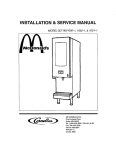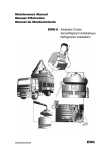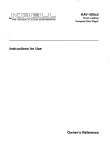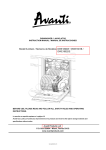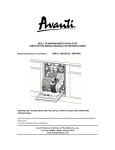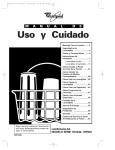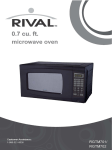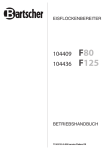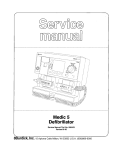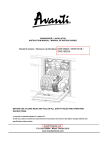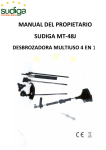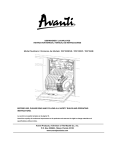Download Avanti DW6W dishwasher
Transcript
PORTABLE DISHWASHER / LAVAPLATOS PORTATIL INSTRUCTION MANUAL / MANUAL DE INSTRUCCIONES Model Numbers / Números de Modelos: DW6W / DW6PS BEFORE USE, PLEASE READ AND FOLLOW ALL SAFETY RULES AND OPERATING INSTRUCTIONS. La sección en español empieza en la página 23. Avanti has a policy of continuous improvement on its products and reserves the right to change materials and specifications without notice. Avanti Products, A Division of The Mackle Co., Inc. P.O. Box 520604 - Miami, Florida 33152 www.avantiproducts.com 1 TABLE OF CONTENTS Help Us Help You 3 Parts and Features / Control Panel 4 Important Safety Features 5 Water Heater Safety 5 Electrical Connection 6 Installation Instructions 7–9 Connecting the Drain Hose 9 Before Using Your Dishwasher 10 Operating Instructions 10 – 11 Cycle Sequence 12 Detergent Dispenser 13 Rinse-Aid Dispenser 14 Loading the Dishwasher 15 – 16 Care and Maintenance 17 – 18 Troubleshooting Guide 19 – 20 Error Codes 21 Service for Your Dishwasher 21 Your Avanti Products Warranty 22 Instrucciones en Español 23 – 34 Registration Information and Registration Card 35 2 HELP US HELP YOU... Write down the model and serial numbers. Read this guide carefully. You'll find them on a plate located on the rear wall of the dishwasher. It is intended to help you operate and maintain your new dishwasher properly. Please write these numbers here: Keep it handy to answer your questions. If you don't understand something or you need more assistance, please call: ____________________________________ Date of Purchase Avanti Customer Service 800-220-5570 ____________________________________ Model Number Keep proof of original purchase date (such as your sales slip) with this guide to establish the warranty period. ____________________________________ Serial Number Use these numbers in any correspondence or service calls concerning your dishwasher. If you received a damaged dishwasher, immediately contact the dealer (or builder) that sold you the dishwasher. Save time and money. Before you call for service, check the Troubleshooting Guide. It lists causes of minor operating problems that you can correct yourself. IF YOU NEED SERVICE NEXT, if you are still not pleased, write all the details, including your telephone number, and send it to: We're proud of our service and want you to be pleased. If for some reason you are not happy with the service you receive, here are some steps to follow for further help. FIRST, contact the people who serviced your dishwasher. Explain why you are not pleased. In most cases, this will solve the problem. Customer Service Avanti Products th 10880 NW 30 Street Miami, FL 33172 3 PARTS AND FEATURES 1 2 3 4 5 6 Front View (Open) 1 Cup Shelf 2 Detergent Dispenser 3 Cutlery / Silverware Basket 4 Filter Assembly 5 Rinse-Aid Dispenser 6 Water Spray Arm 7 Rack 7 Rear View 8 Drain Pipe Connector 9 Water Inlet Pipe Connector 8 9 Control Panel 1 2 3 Rinse-Aid Warning Indicator Start / Reset Light Start / Reset Button 4 5 6 4 Wash Program / Cycle Selector Knob ON / OFF Power Button Power Indicator Light IMPORTANT SAFETY INSTRUCTIONS READ ALL INSTRUCTIONS BEFORE USING. WARNING! For your safety, the information in this manual must be followed to minimize the risk of fire or explosion, electric shock, or to prevent property damage, personal injury, or death. WATER HEATER SAFETY Under certain conditions hydrogen gas may be produced in a water heater that has not been used for two weeks or more. HYDROGEN GAS IS EXPLOSIVE. If the hot water has not been used for two weeks or more, prevent the possibility of damage or injury by turning on all hot water faucets and allow them to run for several minutes. Do this before using any electrical appliance which is connected to the hot water system. This simple procedure will allow any built-up hydrogen gas to escape. Since the gas is flammable, do not smoke or use an open flame or appliance during this process. Use this appliance only for its intended purpose as described in this Owner′s Manual. PROPER INSTALLATION AND MAINTENANCE This dishwasher must be properly installed and located in accordance with the Installation Instructions before it is used. Connect to a grounded metal, permanent wiring system; or run an equipment grounding conductor with the circuit conductors and connect to the equipment grounding terminal or lead of the appliance. Improper connection of the equipment grounding conductor can result in a risk of electric shock. Check with a qualified electrician or service representative if you are in doubt whether the appliance is properly grounded. Dispose of discarded appliances and shipping or packing material properly Do not attempt to repair or replace any part of your dishwasher unless it is specifically recommended in this manual. All other servicing should be referred to a qualified technician. To minimize the possibility of electric shock, disconnect this appliance from the power supply before attempting any maintenance. NOTE: Turning the dishwasher off does not disconnect the appliance from the power supply. We recommend having a qualified technician service your appliance. CAUTION: To prevent minor injury or property damage Contents washed in anti-bacterial mode, if available, may be hot to the touch. Use care before handling. Using a detergent that is not specifically designed for dishwasher will cause the dishwasher to fill with suds. If your dishwasher is connected to a wall switch, ensure that the switch is prior to use. Non-dishware items: Do not wash items such as electrical cleaner filter, furnace filters and paint brushes in your dishwasher and discoloration or staining of dishwasher may result. Close supervision is necessary if this appliance is used by or near children. On dishwashers with electronic controls, if you chose turn the switch off between wash cycles, allow 5-10 seconds after turning the switch on before touching the switch START/RESET to allow the control to reboot. 5 ELECTRICAL CONNECTION Warning Improper use of the grounded plug can result in the risk of electrical shock. If the power cord is damaged, have it replaced by an authorized Avanti Products service center. This appliance should be properly grounded for your safety. The power cord of this appliance is equipped with a three-prong plug which mates with standard three prong wall outlets to minimize the possibility of electrical shock. Do not under any circumstances cut or remove the third ground prong from the power cord supplied. For personal safety, this appliance must be properly grounded. This appliance requires a standard 115/120 Volt AC ~/60Hz electrical ground outlet with three-prong. Have the wall outlet and circuit checked by a qualified electrician to make sure the outlet is properly grounded. When a standard 2-prong wall outlet is encountered, it is your responsibility and obligation to have it replaced with a properly grounded 3-prong wall outlet. The cord should be secured behind the appliance and not left exposed or dangling to prevent accidental injury. The appliance should always be plugged into its own individual electrical outlet which has a voltage rating that matches the rating label on the appliance. This provides the best performance and also prevent overloading house wiring circuits that could cause a fire hazard from overheated. Never unplug the appliance by pulling the power cord. Always grip the plug firmly and pull straight out from the receptacle. Repair or replace immediately all power cords that have become frayed or otherwise damaged. Do not use a cord that shows cracks or abrasion damage along its length or at either end. When moving the appliance, be careful not to damage the power cord. EXTENSION CORD Because of potential safety hazards under certain conditions, it is strongly recommended that you do not use an extension cord with this appliance. However, if you must use an extension cord it is absolutely necessary that it be a UL/CUL-Listed, 3-wire grounding type appliance extension cord having a grounding type plug and outlet and that the electrical rating of the cord be 115 volts and at least 10 amperes. SURGE PROTECTOR Most electrical appliances use a series of electric control boards to operate. susceptible to power surges and could be damaged or destroyed. These boards are very If the appliance is going to be used in an area or if your city / country is prone to power surges / outages; it is suggested that you use a power surge protector for all electrical devices / appliances you use. The surge protector that you select must have a surge block high enough to protect the appliance it is connected to. If you have any questions regarding the type and size of surge protector needed contact a licensed electrician in your area. Damages due to power surges are not considered a manufacturer covered defect and will void your product warranty. 6 WARNING: When using your dishwasher, follow basic precaution, including the following: Use this appliance only for its intended purpose as described in this owner’s manual. Use only powder, tabs, liquid detergents or rinse agents recommended for use in a dishwasher and keep them out of the reach of children. Locate the sharp items so that they are not likely to damage the door seal. Load the sharp knives with the handles up to reduce the risk of cut-type injuries. Do not wash plastic unless marked dishwasher safe or the equivalent. For plastic items not so marked check the manufacturer’s recommendations. Do not operate your dishwasher unless all enclosure are properly in place. Do not tamper with controls. Do not abuse, sit on or stand on the door or dish rack of the dishwasher. Do not allow children to play around the dishwasher when opening or closing door due the possibility of small fingers being pinched in door. Do not discard the dishwasher without removing the door of the washing compartment. Do not store or use combustible materials, gasoline or other flammable vapors and liquids in the vicinity of this or any other appliance. Do not allow children to play with, on or inside this appliance or any discarded appliance. REDA AND FOLLOW THIS SAFETY INFORMATIONCAREFULLY. SAVE THESE INSTRUCTIONS Installation instructions WARNING A hose that attaches to a sink spray can burst if it is installed on the same water line as the dishwasher. If your sink has one, it is recommended that the hose be disconnected and the hole plugged. Remove All Packaging Materials Carefully. If your existing faucet adapter is not compatible with the “quick connect” hose assembly supplied; • Connect the faucet adapter (included with dishwasher) to your faucet. • If your faucet is inclusive of a ‘male’ type (threaded) connection, use only the standard rubber washer (0.2”/5mm thick) supplied inside the adapter. Remove the second rubber washer. • If your faucet is inclusive of a ‘female’ type (threaded) connection, both rubber washers must be installed inside the faucet adapter. • The minimum height clearance required to install your dishwasher on a counter top surface with overhead cupboards is 45cm (17.7”). • Make sure there is an electrical supply (outlet) within reach of the electrical power supply cord (195 cm / 6.3 ft). • Make sure the water supply/faucet connection is within reach of the inlet & drain hose assembly (i.e., 58 cm / 22.8”). • The dishwasher must be installed on a solid, level surface. Water Pressure For best operating results, incoming water pressure should be between 15 and 20 pounds per square inch (psi). 7 For the Best Results: Your dishwasher cleans by spraying a mixture of hot clean water and detergent (under pressure) against the soiled surfaces of dishes. The water is pumped through a rotating spray arm, drained through a filter (removing food and soiled particles) and pumped back through the spray arm. Soiled water is pumped out and replaced with clean water at the end of each cycle, (the number of times depends on the wash program being used). For best cleaning results, the water temperature must be at least 55ºC (130ºF). To prevent damage to the dishwasher, the temperature of the incoming water supply should not exceed 65ºC (149ºF). Connecting your dishwasher Your dishwasher comes equipped with a ‘quick connect’ assembly (includes inlet and drain hose). The faucet adapter must be installed on the faucet before you can connect the dishwasher. This adapter is included inside your dishwasher. The faucet adapter is compatible with faucets inclusive of either male (outside) or female (inside) threaded faucet connections. • Screw the faucet adapter onto (or into) the faucet tap. Check for leaks (use Teflon tape to eliminate if necessary). • Connect the six-sided connection of the drain hose to the drain port connection on the back of the dishwasher cabinet. Do not over-tighten (to avoid damage to threads). • Connect the star-shaped connection of the inlet hose to the inlet port on the back of the dishwasher cabinet. Do not over-tighten (to avoid damage to threads). • Connect the circular connection of the drain hose onto the longer (bottom) male connection on the quick connect. • Connect the circular connection of the inlet hose onto the shorter (top) male connection on the quick connect. • Attach the quick connect onto the faucet adapter, by pulling down the outer locking collar on the quick connect, while pushing the quick connect upward onto the faucet adapter. • When the quick connect snaps onto the faucet adapter, release the locking collar. Verify the connection is secure. • Slowly open the hot water line and check for any sign of water leaks at all hose connections. If leaks are located, immediately close the water supply and repair the hose connections. IMPORTANT • Once you open the water supply line, (even if it is closed immediately thereafter), the inlet hose will be pressurized. • To relieve water pressure from inside the inlet hose, (make sure the water line (faucet) is closed): press and hold the red pressure relief button on the quick connect until the flow of water stops. WARNING FAILURE TO RELIEVE WATER PRESSURE, BEFORE DISCONNECTING THE QUICK-CONNECT FROM THE FAUCET, WILL RESULT IN BACK-PRESSURE OVER-SPRAY. THE TEMPERATURE OF INCOMINGWATER CAN BE VERY HOT, AND BACK-PRESSURE OVER-SPRAY COULD CAUSE SEVERE BURNS AND/OR SCALDING. DANGER DO NOT LET CHILDREN DISCONNECT THE DISHWASHER; CLOSE SUPERVISION OF CHILDREN IS ALWAYS IMPORTANT AROUND APPLIANCES. 8 NOTE: Hard water conditions will adversely affect the washing performance of your dishwasher. Hard water conditions will also contribute to ‘lime’ (white film substance) deposits and/or ‘scaling’ on the stainless steel surface of the dishwasher tub and heater element, located in the sump underneath the removable filter screen. To assist in minimizing these conditions, it is recommended to periodically operate/rinse the inside of the dishwasher (empty) using 1 cup of white vinegar at least once a week. Disconnecting your Dishwasher • Shut off the hot water supply at the faucet. • Disconnect the power supply cord. • Remember to release the water pressure inside the inlet hose. Press and hold the red pressure relief button on the quick-connect until the flow of water stops. • Disconnect the quick-connect hose assembly by pulling down on the outer locking collar, (thus releasing the quick-connect from the faucet adapter). Before Using Your Dishwasher Remove the exterior and interior packing. Check to be sure you have all of the following parts: 1 Rack 1 Cutlery / Silverware Basket 1 Measuring Spoon 1 Measuring Cup 1 Instruction Manual Clean the interior surface with lukewarm water using a soft cloth. Operating Instructions To get the best performance from your dishwasher, read all operating instructions before using it for the first time. You can locate your model number on the tub wall just inside the door. Throughout this manual, features and appearance may vary from your model. Control Panel 1 2 3 Rinse-Aid Warning Indicator Start / Reset Light Start / Reset Button Light – OFF Light - ON Light – Flashing 4 5 6 Wash Program / Cycle Selector Knob ON / OFF Power Button Power Indicator Light Status Indicator Light – Description Dishwasher is in Stand-by mode. Dishwasher is in PAUSE mode. Dishwasher is in RUN mode. 9 Operating Your Dishwasher a) Ensure that all Electrical, Water, and Drain connections have been installed correctly before proceeding. b) Load the dishwasher accordingly (See the “Loading the Dishwasher Rack” section on pages 15 – 16). c) Add the appropriate amount of dishwasher detergent to the dispenser (See the section “Proper Use of Detergent” on page 13). d) Close the door and ensure that the door latch has engaged. e) Turn the dishwasher ON by pressing the ON / OFF button. f) Select the appropriate wash cycle / program (See the Cycle Sequence / Program Description section on page 12). g) Make sure that the water supply is turned on to full pressure. h) Press the Start/Reset button, the dishwasher will begin to start. The START / RESET indicator light will begin to flash intermittently to indicate the dishwasher is in “RUN” mode. NOTE: When you press the Start/Reset button to pause during washing, the program light will stop blinking and the dishwasher will beep once every minute unless you press the Start/Reset button to start (See Pausing the Wash Program / Cycle). Pausing the Wash Cycle / Program: In order to make any changes to the selected wash program / cycle, load additional items, or remove previously loaded items the dishwasher must be put in a “PAUSED” status. The dishwasher can be put into PAUSE mode at any time during the wash cycle. To temporarily pause the washing process follow these steps: a) Press and hold the START / RESET button for approximately 3 seconds. (The START / RESET indicator light with be ON indicating that the unit is in PAUSE mode. While in the PAUSE mode you will hear a beep once every minute until the dishwasher is put back into normal operation or “RUN” mode.) b) Make the necessary changes to the wash program / cycle selection, add/remove the items from the dishwasher. c) Ensure that the door is closed and the latch is fully engaged. d) Press the START / REST button once e) The dishwasher will immediately resume operation using the selected wash program / cycle. NOTE: If the door is opened at any time during the washing process, the dishwasher will automatically go to the PAUSE mode. Once the door is closed and the latch is fully engaged the dishwasher will immediately resume operation as normal. Although the dishwasher will be put in the PAUSE mode by opening the door, it is recommended that you follow the steps above to PAUSE the washing process. 10 Changing the Wash Program / Cycle: If at any time during the washing process you would like to change the selected wash program / cycle; follow the steps below: a) Press and hold the START / RESET button for approximately 3 seconds. (The START / RESET indicator light will be ON indicating that the unit is in PAUSE mode.) b) Select the new wash program / cycle by turning the selector knob to the appropriate program / cycle. c) Press the START / RESET button again, the dishwasher will resume operation using the newly selected wash program / cycle. NOTE: If you change the wash program / cycle after the detergent has been dispensed or the dishwasher has already drained the wash water, you will need to refill the detergent dispenser for the newly selected program / cycle accordingly. (See the section “Proper Use of Detergent on page 13) At the End of the Wash Cycle Once the dishwasher has completed the selected wash cycle / program, there will be a buzzer sound for 8 seconds indicating the end of the cycle and then stop. a) Shut off the water supply. b) Turn the dishwasher OFF by pressing the ON/OFF button. c) Slightly open the door with caution to allow any residual steam to escape. d) Wait a few minutes (approximately 15 minutes) before unloading the dishwasher as the dishes and cutlery will be hot. This also allows the dishes not only time to cool down but also aids in drying. e) Unload the dishwasher and store your dishes and cutlery as normal. f) The interior of the dishwasher will be wet, this is normal and will dry naturally. WARNING: It is dangerous to open the door when washing, because the hot water may scald you. Check the Water Temperature For the most effective cleaning and to prevent damage to the dishes being cleaned, the water supplied to the dishwasher should be at a temperature of at least 120ºF (49ºC) and no more than 150ºF (66ºC). Using a candor or meat thermometer, place the thermometer in a glass under the faucet that will be used for the dishwasher and allow the HOT water to continuously run and fill the glass. Once the temperature stops rising this is the highest temperature of the water from that faucet. 11 Cycle Sequence Cycle Heavy Normal Light Glass Water (Approx) 4.2 Gallons 3.6 Gallons 3.0 Gallons 2.4 Gallons Rapid 3.0 Gallons Pre-Wash 0.7 Gallons Time (Approx) 115 Minutes Sequence Pre-wash Pre-wash (122ºF/50ºC) Pre-wash (122ºF/50ºC) Wash (140ºF/60ºC) Wash (122ºF/50ºC) Rinse Rinse (149ºF/65ºC) Dry 80 Minutes Pre-wash Pre-wash Pre-wash Wash (131ºF/55ºC) Rinse Rinse (149ºF/65ºC) Dry 80 Minutes Pre-wash Pre-wash (122ºF/50ºC) Wash (122ºF/50ºC) Rinse Rinse (140ºF/60ºC) Dry 65 Minutes Pre-Wash Wash (122ºF/50ºC) Rinse Rinse (140ºF/60ºC) Dry 50 Minutes Pre-wash Pre-wash (122ºF/50ºC) Wash (122ºF/50ºC) Rinse Rinse (131ºF/55ºC) 10 Minutes 12 Pre-wash Proper Use of Detergent Use only detergent specifically made for use in dishwashers. Keep your detergent fresh and dry. Do not put powder detergent into the dispenser until you’re ready to wash dishes. The amount of detergent to use depends on whether your water is hard or soft. With hard water, you need extra detergent. With soft water, you need less detergent. Protect your dishes and dishwasher by contacting your water department and asking how hard your water is. Twelve or more grains is extremely hard water. A water softener is recommended. Without it, lime can build up in the water valve, which could stick while open and cause flooding. Too much detergent with soft water can cause a permanent cloudiness of glassware, called etching. For heavily soiled loads, use the HEAVY, NORMAL WASH Cycle, fill one or both of the interior cups, depending on the hardness of your water, and also fill the open cup on the dispenser lid. Use the information in the table below as a guideline to determine the amount of automatic dishwasher detergent to place in the dispenser: Number of Grains Less than 4 4 to 8 8 to 12 Greater than 12 Detergent Cups to Fill 15 cup 25 cup 15 and 25 cups 15, 25 cups and the open cup To open the wash cover, press the button and the cover will flip back. After you finish, please close the cover. See below: NOTE: DO NOT USE HAND DISH DETERGENT Using a detergent that is not specifically designed for dishwashers will cause the dishwasher to fill with suds. During operation, these suds will spill out of the dishwasher vents, covering the kitchen floor and making the floor wet. Because so many detergent containers look alike, store the dishwasher detergent in a separate space from all other cleaners. Show anyone who may use the dishwasher the correct detergent and where it is stored. While there will be no lasting damage to the dishwasher, your dishes will not get clean using a dishwashing detergent that is not formulated to work with dishwashers. 13 Use Jet-Dry Rinse Agent Jet-Dry rinse agent removes spots and prevents new film buildup on your dishes, glasses, flatware, cookware and plastic. Filling the Dispenser The rinse agent dispenser holds 3.5 oz. of rinse agent. Under normal conditions, this will last approximately one month. Try to keep it full, but do not overfill. 1) Make sure the dishwasher door is fully open. 2) Turn the dispenser knob to the left and lift it out. 3) Add rinse agent until the indicator window looks full. 4) Clean up any spilled rinse agent with a damp cloth. 5) Replace the dispenser knob. Rinse Aid Setting The amount of rinse agent released into the final wash can be adjusted. The factory setting is at the midpoint. If there are rings of calcium (hard water) spots on dishes, try a higher setting. To adjust the setting Remove the dispenser knob; then turn the adjuster counterclockwise to increase the amount of rinse agent. 14 Loading the Dishwasher Rack Position the dishes and cookware so that they will not get moved by the spray of water. To remove the plate bracket from the rack: 15 Silverware Basket Silverware should be placed in the Silverware basket with handles at the bottom. If the rack has side baskets, the spoon should be loaded individually into the appropriate slots, especially long utensils should be placed in the horizontal position on the cup shelf. WARNING: Do not let any item extend through the bottom of the rack or cutlery basket. WARNING: Always load sharp utensils with the sharp point down! For personal safety and a top quality cleaning, place the silverware in the basket ensure the following: • • • They do not nest together. Place silverware with handles-down. But place knives and other potentially dangerous utensils handles-up. Forget to Add a Dish? You can load additional dishes / cutlery at any time before the detergent dispenser cup opens. 1 2 3 4 5 6 Press and hold the START / RESET button for approximately 3 seconds. (The START / RESET indicator light will be on indicating that the dishwasher is in PAUSE mode). Slowly open the door to both stop the water spray arm and to release any steam if applicable. Once the water spray arm has stopped, you can open the door completely. Add the additional items to the wash rack. Close the door Press the START / Reset button again, the dishwasher will resume operation after 10 seconds. 16 Care and Maintenance Instructions Filter system The filter system consists of a coarse filter, a flat (Main filter) And a micro filter (Fine filter). 1. Main filter: Food and soil particles trapped by this filter are pulverized by a special jet on the spray arm and washed down to drain. 2. Fine filter: This filter holds soil and food residue in the sump area and prevents it from being redeposit on the dishes during wash cycle. 3. coarse filter Larger items, such as pieces of bone or glass, that could block the drain are trapped in the coarse filter. To remove the items caught by the filter, gently squeeze the tap on the top of this filter and lift out. The filter efficiently removes food particles from the wash water, allowing it to be re-cycled during the cycle. For best performance and results, the filter assembly must be regularly. For this reason, it is a good idea to remove the larger food particles trapping in the filter after each wash cycle by rinsing the filter assembly under running water. To clean the coarse filter and the fine filter, use a soft cleaning brush. Reassemble the filter parts as shown in following and reinsert the entire assembly in the dishwasher, positioning in its seat and pressing downward. To remove the filter assembly, grab the handle of the fine filter, rotate it anti-clockwise then pull upward direction. Step1: rotate the fine filter anti-clockwise; Step2: lift it up; Step3: lift the Main filter up NOTE: If do it from step1 to step 3, the filter system will be removed; while if do it from Step 3 to Step 1, the filter system will be installed. Remarks: - Inspect the filters for blocking every time the dishwasher has been used. - By unscrewing the coarse filter. you can remove the filter system. Remove any food remnants and clean the filters under running water. 17 WARNING: ·Never run the dishwasher without the filters in place. ·The dishwasher must never be used without the filters. ·Improper replacement of the filter may reduce the performance level of the appliance and damage dishes and utensils. ·The entire filter system should be cleaned once a week ·When cleaning the filters, don't knock on them. Otherwise, the filters could be contorted and the performance of dishwasher could be debased. Cleaning The Spray Arm It is necessary to clean the spray arm regularly for hard water chemicals will clog the spray arm jets and bearings. To remove the spray arm, screw off the nut to take out the washer on top of the spray arm and remove the arm. Wash the arm in soapy and warm water and use a soft brush to clean the jets. Replace it after rinsing thoroughly. Cleaning The Control Panel. • • To clean the control panel use a lightly dampened cloth then dry thoroughly. To clean the exterior use a good appliance polish wax. Never use sharp objects, scouring pads or harsh cleaners on any part of the dishwasher. Cleaning The Door To clean the edge around the door, you should use only a soft warm, damp rag. To prevent penetration of water into the door lock and electrical components, do not use a spray cleaner of any kind. Also, never use abrasive cleaners or scouring pads on the outer surfaces because they will scratch the finish. Some papers towels can also scratch or leave marks on the surface. WARNING - Never use a spray cleaner to clean the door panel for it could damage the door lock and electrical components. It is not allowed to use the abrasive agent or some paper towel because of the risk of scratching or leaving spots on the stainless steel surface. How To Keep You Dishwasher In Shape After every wash After every wash, turn off the water supply to the appliance and leave the door slightly ajar so that moisture and odors are not trapped inside. No solvents or abrasive cleaning products To clean the exterior and rubber parts of the dishwasher, do not use solvents or abrasive cleaning products. Rather, use only a cloth and warm soapy water. To remove spots or stains from the surface of the interior, use a cloth dampened with water and a little white vinegar, or a cleaning product made specifically for dishwashers. Seals One of the factors that cause odors to form in the dishwasher is food that remains trapped in the seals. Periodic cleaning with a damp sponge will prevent this from occurring. 18 Troubleshooting tips Save time and money! Review the charts on the following pages. You may not need to call for service. Problem Possible Causes What To Do: Dishwasher does not start Fuse is blown or the circuit breaker has tripped. Replace the fuse or reset the circuit breaker. Remove any other appliances sharing the same circuit with the dishwasher. • Make sure the dishwasher is turned on and the door is closed securely. • Make sure the power cord is properly plugged into the wall socket. Close the door making sure the door latch is engaged. Check the drain hose and ensure there are no kinks. Check the filter assembly and remove any debris if any that may be blocking the filter. Check the kitchen sink for adequate drainage. If the kitchen sink is not draining you may need to contact a local plumber to inspect your drainage pipe. Use only detergent specifically designed and marked for use with dishwashers. If this occurs, open the dishwasher and let the suds evaporate. Add approximately 1 gallon of cold water to the tub, close the door ensuring the latch is engaged. Select the “PRE-WASH” program. Press the Start / Rest button to drain out the water. Repeat if necessary. Always wipe up rinse-aid spills immediately. Make sure you use detergents without colorants. Wearing rubber gloves, clean the interior using a damp sponge with a small amount of dishwasher detergent. Never use any cleaners other than dishwasher detergent to avoid the risk of over-sudsing. These items are not suitable for dishwasher use. Power supply is not turned on. Water is not pumped from the dishwasher Dishwasher door is not closed properly. Drain hose is kinked Filter is clogged Kitchen sink is clogged Suds in tub Improper detergent Spilled rinse-aid Stained tub interior Detergent with colorant was used. White film on the inside surface Hard water minerals There are rust stains on silverware / cutlery The affected items are not corrosion resistant Knocking noise in the washing cabinet The spray arm is knocking against an item loaded in the rack. Rattling noise in the washing cabinet Knocking noise in the water pipes Items are not loaded securely and are vibrating against each other This may be caused by shaking plumbing or loose connections at cross-sections in the piping. 19 Pause the wash cycle and rearrange the items accordingly to remove any item blocking the spray arm rotation. Pause the wash cycle and rearrange the items accordingly. This has no influence on the dishwasher operation. If in doubt contact a qualified plumber. The dishes are not clean. The dishes were not loaded correctly The program selected was not the appropriate cycle for the condition of the dishes. Not enough detergent was dispensed. Items were blocking the rotation path of the water spray arm. The filter assembly in the base of the unit is not clean, is clogged, or is not installed correctly. (This may cause the spray arm jets to become clogged). Cloudiness on the glassware. This is a combination of soft water and too much detergent. Black or gray marks on dishes. Detergent left in the dispenser cups. Aluminum utensils have rubbed against the dishes. Dishes blocked the detergent cups not allowing them to open completely during the wash cycle. Improper loading The dishes are not dry Too little rinse-aid Dishes were removed from the washer too soon. Wrong program / cycle selected. Using cutlery with a low quality coating. 20 See the notes in Loading the Dishwasher section of this manual. Select a more intense program. Use more detergent, or change the type of detergent being used. Rearrange the items accordingly so that the spray arm can rotate freely. Clean and / or fit the filter assembly correctly. Clean the spray arm jets. See the Cleaning the Spray Arm section of this manual. Use less detergent if you have soft water and select a shorter cycle to wash the glassware to get them clean. Use a mild abrasive cleaner to remove the marks Re-load the dishes accordingly and re-run the wash cycle. Load the dishwasher as suggested in the Loading your dishwasher section of this manual. Increase the amount of rinse-aid dispensed or refill the rinse-aid dispenser if empty. Do not empty your dishwasher immediately after the cycle ends. Open the door slightly so that the steam can escape. Begin unloading the dishwasher once the dishes are barely warm to the touch. When using the shorter cycles/programs the washing temperatures are lower. This also lowers the cleaning performance. Choose a cycle / program with a longer wash time. Water drainage is more difficult with these items . Cutlery or dishes of this type are not suitable for dishwasher use. Error codes When some malfunctions occur, the appliance will display error codes to warn you: Codes The Start/Reset light blinks intermittently. Meanings Possible causes Longer inlet time. Faucets is not opened, or water intake is restricted, or water pressure is too low. Some element of dishwasher leaks Overflow WARNING: ·If overflow occurs, turn off the main water supply before calling a service. ·If there is water in the base pan because of an overfill or small leak, the water should be removed before restarting the dishwasher. SERVICE FOR YOUR DISHWASHER We are proud of our customer service organization and the network of professional service technicians that provide service on your Avanti dishwashers. With the purchase of your Avanti dishwasher, you can have the confidence that if you ever need additional information or assistance, the Avanti Products Customer Service team will be here for you. Just call us toll-free. AVANTI PRODUCTS CUSTOMER SERVICES Product Information 800-323-5029 Part Orders 800-220-5570 In-Home Repair Service 800-220-5570 Whatever your questions are about our products, help is available. You may order parts and accessories that will be delivered directly to your home, by personal check, money order, Master Card, or Visa. An Avanti Products authorized service center will provide expert repair service, scheduled at a time that is convenient for you. Our trained servicers know your dishwasher inside and out. 21 YOUR AVANTI PRODUCTS WARRANTY Staple your sales receipt here. Proof of original purchase date is needed to obtain service under warranty. WHAT IS COVERED LIMITED ONE-YEAR WARRANTY For one year from the date of purchase by the original owner, Avanti Products will, at its option, repair or replace any part of the dishwasher which proves to be defective in material or workmanship under normal use. During this period Avanti Products will provide all parts and labor necessary to correct such defects free of charge, so long as the dishwasher has been installed and operated in accordance with the written instructions in this manual. Avanti Products will provide you with a reasonably similar replacement product that is either new or factory refurbished. In rental or commercial use, the warranty period is 90 days. All Avanti Appliances of 3.5 cubic feet capacity or less must be brought/sent to the appliance service shop for repair. WHAT IS NOT COVERED Incidental or consequential damages. Parts and labor costs for the following will not be considered as warranty: Doors, door springs, and/or frames. Inner door panels, door shelves, door rails, and/or door supports. Light bulbs and/or plastic housing. Plastic cabinet liners. Shipping and Handling costs associated with the replacement of the unit. Repairs performed by unauthorized servicers. Service calls that do not involve defects in material or workmanship such as customer education, door reversal, or proper installation. Service calls that are related to external problems, such as abuse, misuse, inadequate electrical power, accidents, fire, floods, or acts of God. Surcharges including, but not limited to, any after hour, weekend, or holiday service calls, tolls, ferry trip charges, or mileage expense for service calls to remote areas, including the state of Alaska. Replacement of house fuses or resetting circuit breakers. Failure of the product if it is used for other than its intended purpose. This warranty does not apply outside the Continental U.S.A.. 22 INSTRUCCIONES EN ESPAÑOL INFORMACIONES IMPORTANTES DE SEGURIDAD Para reducir el riesgo de incendio, descarga PRECAUCION eléctrica, o daño cuando use su electrodoméstico, siga las siguientes precauciones. Lea todas las instrucciones antes de usar su electrodoméstico. Peligro o Precaución: Existe el riesgo que los niños queden atrapados. Niños atrapados o sofocamiento no son un problema del pasado. Los electrodomésticos son peligrosos aún si solo los deja en el garaje por un par de días. Antes de desechar su equipo usado: quítele las puertas. Deje la repisa en su lugar para evitar que los niños se queden atrapados. No permita que los niños manejen, jueguen o entren dentro del electrodoméstico. No limpie su electrodoméstico con líquidos inflamables. Los gases pueden ocasionar fuego o una explosión. No guarde ni use gasolina u otros líquidos inflamables cerca de este o de cualquier otro electrodoméstico. Los vapores pueden ocasionar fuego o explosión. - Guarde estas instrucciones.ADVERTENCIA Cuando use el lavaplatos siga las instrucciones básicas indicadas a continuación ADVERTENCIA. EL HIDROGENO ES UN GAS EXPLOSIVO Bajo ciertas condiciones, el gas de hidrogeno se puede producir en un sistema de agua caliente que no ha sido usado por más de dos semanas. EL HIDROGENO ES UN GAS EXPLOSIVO. Si el sistema de agua caliente no va a ser usado por un período de tiempo, cierre todas las llaves de agua caliente y deje correr el agua fría por varios minutos antes de usar el lavaplatos. Esto liberará cualquier residuo de gas hidrógeno acumulado. Debido a lo inflamable de este gas, no fume o haga fuego alrededor. USO APROPIADO No maltrate, se siente o se pare en la puerta o la bandeja del lavaplatos. No toque el calentador durante o justamente después de usar el lavaplatos. No lave artículos de plástico, a menos que estos indiquen que son aptos para lavaplatos, para los artículos que no lleven indicación, lea las recomendaciones del fabricante. Use sólo detergentes y aditivos de enjuague diseñados para lavaplatos automáticos. No use jabón, detergente para ropa o detergente de lavado a mano en su equipo. Mantenga el detergente y los aditivos de enjuague fuera del alcance de los niños. Mantenga a los niños lejos del lavaplatos cuando la puerta esté abierta, ya que podrían quedar residuos de detergente en el interior. La puerta no debe quedar abierta, ya que podría causar tropiezos y caídas. Durante la instalación, el sistema de suministro eléctrico no debe estar doblado o aplanado. Para reducir el riesgo de accidentes, no permita a los niños jugar en o con el lavaplatos. No utilice su lavaplatos a menos que todos los paneles interiores estén en su lugar. Abra cuidadosamente el lavaplatos si este esta operando, existe el riesgo de una fuga de agua. No coloque objetos pesados sobre la puerta abierta. El equipo podría inclinarse hacia adelante. Cuando esté cargando los artículos a limpiar: Coloque los artículos afilados de manera que no dañen el sello de la puerta. Coloque los filos de los cuchillos hacia abajo para reducir el riesgo de cortes. Si el cordón del enchufe esta dañado, deberá ser reemplazado por el fabricante, su agente de servicios o una persona calificada. Deshágase de los materiales de empaque apropiadamente. Use el lavaplatos sólo para las funciones para las que fue diseñado. Quite la puerta del compartimiento de lavado cuando cambie o deseche un lavaplatos. No juegue con los controles. 23 Conexión Eléctrica ADVERTENCIA EL USO INAPROPIADO DEL ENCHUFE A TIERRA PUEDE OCASIONAR RIESGO DE UN CHOQUE ELECTRICO. SI EL CORDON SE DAÑASE, LLEVELO A UN CENTRO DE SERVICIO AUTORIZADO POR AVANTI PRODUCTS PARA QUE SE REEMPLACE. • • • • • • Bajo ninguna circunstancia corte o retire la tercera punta (cable a tierra) del enchufe del cordón eléctrico. Nunca use un cable de extensión para conectar la unidad a la electricidad. Nunca use un adaptado con enchufe de solo 2 puntas. Si solo puede conectar la máquina de hacer hielo a un receptáculo/enchufe de pared de 2 puntas, comuníquese con un electricista calificado para que reemplace ese receptáculo/enchufe de pared por uno de 3 puntas, de acuerdo con los códigos de electricidad aplicables. Esta máquina de hacer hielo requiere un receptáculo/enchufe de pared de tres puntas estándar de 115/120 voltios a.c.~/60hz. Para prevenir cualquier daño físico o lesión, el cordón debe ser asegurado detrás de la máquina de hacer hielo y no estar expuesto o colgando. Cable de Extensión Debido al posible riesgo de seguridad causado bajo ciertas circunstancias, se recomienda firmemente que no use un cable de extensión para este electrodoméstico. Sin embargo, si no tiene otra opción mas que usar un cable de extensión, asegúrese que este sea un cable de extensión para electrodomésticos que este listado bajo UL/CUL, que tenga enchufe y receptáculo para enchufe de tres puntas (cable a tierra) y que la capacidad del cordón eléctrico sea de 115 voltios y no menos de 10 amperios. Protector contra variaciones de corriente eléctrica (Surge Protector). La mayoría de electrodomésticos utilizan una series de paneles de control para operar. Estos paneles son muy susceptibles a las variaciones de corriente eléctrica, las cuales causan que estos se dañen o destruyen. Si vive en un área o ciudad done hay muchas variaciones de corriente o apagones, se recomienda que utilice un protector contra variaciones de corriente para todos los electrodomésticos y aparatos eléctricos. El protector que elija debe bloquear una variación de electricidad alta para poder proteger el electrodoméstico al cual está conectado. Por favor contáctese con un electricista licenciado en su área si tuviera preguntas en referencia al tipo y tamaño de protector que necesita. Daños debido a variaciones de electricidad no se consideran un defecto del fabricante y podrían anular la garantía. 24 Instrucciones de Instalación ADVERTENCIA Si el grifo que ud. tiene no es compatible con la manguera “Quick Connect” que incluimos entonces: • Conecte el adaptador del grifo (incluido con Lavadora de Platos) a su grifo. • Si su grifo tiene incluida una conexión de rosca tipo “macho”, entonces use solamente la arandela de jebe estándar (0.2”/5mm grosor) que viene dentro del adaptador. Retire la segunda arandela de jebe. • Si su grifo tiene incluida una conexión de rosca tipo “hembra”, entonces ambas arandelas de jebe deben ser instaladas dentro del adaptador del grifo. • La altura mínima requerida para instalar su Lavadora de Platos en la superficie del mostrador de la cocina, si tiene gabinetes de pared sobre la superficie, es de 45cm (17.7”). • Asegúrese que haya un enchufe de suministro eléctrico de pared, al que pueda conectar la Lavadora de Platos directamente (195 cm / 6.3 ft). • Asegúrese que el suministro de agua/ y la conexión del grifo queden cerca de la entrada y drenaje del agua para que alcance la manguera (i.e.,58 cm / 22.8”). • La Lavadora de Platos debe ser instalada en una superficie sólida y nivelada. Presión de Agua Para mejores resultados de operación, la presión de entrada de agua debe ser entre 15 y 20 libras por pulgada cuadrada (psi). Para mejores resultados: Su Lavadora de Platos lava rociando a presión las superficies de los platos con una mezcla de agua caliente fresco y detergente. El agua se bombea a través de un brazo rociador giratorio, luego se drena a través de un filtro (que remueve partículas de comida o suciedad) y bombeada para enjuague a través del mismo brazo. El agua sucia se bota y se reemplaza con agua limpia al final de cada ciclo de lavado (el numero de veces depende en el programa de lavado que se este usando). Para obtener mejores resultados, la temperatura del agua debe ser de por lo menos 55ºC (130ºF). Para prevenir que la Lavadora de Platos se dañe, la temperatura del agua que entra no debe exceder 65ºC (149ºF). Conectando su Lavadora de Platos Su Lavadora de Platos viene equipada con un ensamblaje “Quick Connect” (que incluye una manguera para la entrada del agua y otra para el drenaje). El adaptador del grifo deber ser instalado en el grifo antes que ud. conecte la Lavadora de Platos. Este adaptador viene incluido con su Lavadora de Platos. El adaptador del grifo es compatible con grifos de conexión de rosca que sean tipo “macho” (hacia afuera) o “hembra” (hacia dentro). • Enrosque el adaptador grifo al grifo. Verifique si hay goteos (use cinta de Teflón para eliminar goteos si fuera necesario). • Coloque la conexión de 6-lados de la manguera de desagüe and a la conexión de drenaje que esta en la parte posterior del gabinete de la Lavadora de Platos. Enrosque firmemente, pero con cuidado de no dañar la rosca. • Coloque la conexión de estrella de la entrada de la manguera a la conexión de entrada que esta en la parte posterior del gabinete de la Lavadora de Platos. Enrosque firmemente, pero con cuidado de no dañar la rosca. 25 • Coloque la conexión circular de la manguera de drenaje en la conexión “macho” (abajo/mas larga) del “Quick Connect”. • Coloque la conexión circular de la manguera de entrada en la conexión “macho” (arriba/mas corta) del “Quick Connect”. • Ajuste el ”Quick Connect”al adaptador del grifo, halando hacia abajo el cuello sellador externo del “Quick Connect”, y al mismo tiempo empujando el ”Quick Connect” hacia arriba al adaptador del grifo. • Cuando el ”Quick Connect” entre al adaptador del grifo escuchará un chasquido, entonces libere el cuello sellador. Verifique que la conexión este asegurada. • Lentamente abra la línea del agua caliente y verifique que en todas las conexiones de las mangueras no hayan fugas de agua ni goteo. Si encuentra cualquier fuga de agua o goteo, cierre suministro de agua inmediatamente y arregle las conexiones de la manguera. IMPORTANTE • Una vez que ud. abra la línea del suministro de agua, (aun si la cierra inmediatamente después), la manguera de entrada estará bajo presión (debido al agua que ha entrado). • Para aliviar la presión de agua en la manguera de entrada, (asegúrese que la línea de agua (grifo) este cerrada): presione el botón rojo (de alivio de presión de agua) en el ”Quick Connect” hasta que el flujo de agua pare por completo. ADVERTENCIA ASEGURESE DE ALIVIAR LA PRESION DE AGUA EN LA MANGUERA, ANTES DE DESCONECTAR EL”QUICK CONNECT” DEL GRIFO, YA QUE DE NO HACERLO, LA PRESION DEL AGUA AGUANTADA PUEDE OCASIONAR EL ESCAPE DE UNA FUERTE RAFAGA DE AGUA CALIENTE. LA TEMPERATURA DEL AGUA PUEDE ESTAR TAN CALIENTE QUE ESTA RAFAGA PUEDE CAUSAR QUEMADURAS SEVERAS O ESCALDADURAS. PELIGRO NO PERMITA QUE LOS NIÑOS DESCONECTEN LA LAVADORA DE PLATOS; ES MUY IMPORTANTE MANTENER UNA SUPERVISION CONSTANTE CUANDO HAY NIÑOS CERCA DE LOS ELECTRODOMÉSTICOS. NOTA: El agua “dura” (con depósitos minerales) afecta adversamente la operación de su Lavadora de Platos. El agua “dura” también contribuye a depósitos de calcio (substancia blanca) y/o que aparezcan escamas en el compartimiento donde se colocan los platos y el calentador (localizado en el sumidero debajo del filtro protector removible). Para ayudar a minimizar esta condición, recomendamos que periódicamente, al menos una vez por semana, haga funcionar / enjuague el compartimiento interior de la Lavadora de Platos vacía, usando 1 taza de vinagre blanco. 26 Desconectando su Lavadora de Platos • Cierre el suministro de agua caliente del grifo. • Desconecte el cordón de suministro eléctrico. • Recuerde liberar la presión de agua de la manguera de entrada. Para aliviar la presión de agua en la manguera de entrada, (asegúrese que la línea de agua (grifo) este cerrada): presione el botón rojo (de alivio de presión de agua) en el ”Quick Connect” hasta que el flujo de agua pare por completo. • Desconecte el ensamblaje de la manguera “Quick Connect” halando hacia abajo el cuello sellador externo del “Quick Connect” (y al mismo tiempo liberando el”Quick Connect” del adaptador del grifo). Antes de usar su Lavadora de Platos Retire el empaque externo e interno. Verifique que tenga todas las siguientes partes: 1 canasta 1 canasta para cubiertos 1 cuchara para medir 1 Manual de Instrucciones Limpie la superficie interna con agua tibia usando un paño suave que no arañe. Instrucciones de Operación Para obtener óptimo funcionamiento de su Lavadora de Platos, lea todas las instrucciones de operación antes de usarla por primera vez. Ud. puede localizar el número de modelo en el compartimiento donde se colocan los platos, en la pared. A lo largo de este manual, las características y apariencia de su máquina pueden variar ligeramente. Panel de Control 1 2 3 Indicador para liquido ayuda-enjuague Rinse-Aid Luz indicadora para el botón Start / Reset Botón Start / Reset (Empezar el lavado o cambiar el programa de lavado) Luz apagada – OFF Luz encendida - ON Luz - parpadeando 4 5 6 Programa de lavado / Perilla para seleccionar el Ciclo de lavado Botón de encendido/apagado ON / OFF Luz indicadora si la máquina está encendida Descripción – Luz indicadora de posición Lavadora de Platos está en posición de espera / Stand-by. Lavadora de Platos está en posición de pausa durante el ciclo de lavado / PAUSE. Lavadora de Platos está funcionando / RUN. 27 Operando su Lavadora de Platos a) Asegúrese que todas las conexiones eléctricas, de entrada de agua y de drenaje hayas sido instaladas correctamente antes de proceder. b) Coloque los platos dentro de la Lavadora de Platos (siguiendo las instrucciones de acuerdo a la sección “Colocando platos en la canasta de la Lavadora de Platos Rack”. c) Añada la cantidad apropiada de detergente para Lavadora de Platos al dispensador. d) Cierre la puerta y asegúrese que el seguro de pestillo este colocado. e) Encienda la Lavadora de Platos presionando el botón de encendido / apagado ON / OFF. f) Seleccione el ciclo / programa de lavado deseado (Vea la Secuencia de Ciclos / Programas en la siguiente página g) Asegúrese que el suministro de agua este abierto a la presión de agua máxima. h) Presione el botón para Empezar o Cambiar el programa de lavado Start/Reset. i) La Lavadora de Platos empezará funcionar. NOTA: Cuando presione el botón para Empezar o Cambiar el programa de lavado Start/Reset para detener la maquina durante el ciclo de lavado, la luz indicadora dejará de parpadear y la Lavadora de Platos emitirá un sonido “bip” una vez por minuto hasta que ud. presione el botón para Empezar o Cambiar el programa de lavado Start/Reset para que vuelva a funcionar. Como parar el ciclo de lavado temporalmente. Para hacer algún cambio a la programa de lavado seleccionado, cargar platos adicionales, o retirar algún artículo previamente cargado en el lavaplatos se recomienda poner el lavaplatos en el estado “PAUSA”. Se puede activar el estado de pausa en cualquier momento durante el proceso del lavado. Para activar el estado PAUSA siga este proceso. a) Presione el botón START / REST por aproximadamente 3 segundos. (La luz indicadora encenderá intermitentemente para indicar que el lavaplatos está en estado de pausa). b) Hacer los cambios o selecciones necesarios. c) Cierra la puerta y asegúrese que el seguro de pestillo este colocado. d) Presione el botón START / RESET una vez más. e) El lavaplatos empezará funcionar inmediatamente. NOTA: Si durante el proceso del lavado se abre la puerta, el lavaplatos parará de funcionar automáticamente y estará en PAUSA. En cuanto la puerta está cerrada y el seguro de pestillo este colocado el lavaplatos empezará funcionar inmediatamente. Aunque el lavaplatos parará con la abertura de la puerta se recomienda seguir los pasos detallados arriba. Como cambiar la programa de lavado. Se puede cambiar la programa de lavado en cualquier momento durante el proceso del lavado. Para cambiar la programa seleccionada sigue estos pasos: a) Presione el botón START / REST por aproximadamente 3 segundos. (La luz indicadora encenderá intermitentemente para indicar que el lavaplatos está en estado de pausa). b) Hacer los cambios o selecciones necesarios. c) Cierra la puerta y asegúrese que el seguro de pestillo este colocado. d) Presione el botón START / RESET una vez más. e) El lavaplatos empezará funcionar inmediatamente. NOTA: Si se cambia la programa de lavado después que el lavaplatos haya dispensado el detergente ó vaciado el agua de lavado; será necesario rellenar el dispensador de detergente. 28 SECUENCIA DE CICLOS DE LAVADO Cyclo / Programa Heavy (Intensivo) Normal Light (Ligero) Glass (Vidrio) Cantidad de Agua (Aproximada) 4.2 Galones 3.6 Galones 3.0 Galones 2.4 Galones Tiempo (Aproximada) Secuencia 115 Minutos Pre-enjuague Pre-enjuague (122ºF/50ºC) Pre-enjuague (122ºF/50ºC) Lavado (140ºF/60ºC) Lavado (122ºF/50ºC) Enjuague Enjuague (149ºF/65ºC) Secado 80 Minutos Pre-enjuague Pre-enjuague Pre-enjuague Lavado (131ºF/55ºC) Enjuague Enjuague (149ºF/65ºC) Secado 80 Minutos Pre-enjuague Pre-enjuague (122ºF/50ºC) Lavado (122ºF/50ºC) Enjuague Enjuague (140ºF/60ºC) Secado 65 Minutos Pre-enjuague Lavado (122ºF/50ºC) Enjuague Enjuague (140ºF/60ºC) Secado Rapid (Rapido) 3.0 Galones 50 Minutos Pre-enjuague Pre-enjuague (122ºF/50ºC) Lavado (122ºF/50ºC) Enjuague Enjuague (131ºF/55ºC) Pre-Enjuague 0.7 Galones 10 Minutos Pre-enjuague 29 Dispensador de Detergente El dispensador debe rellenarse antes de comenzar cada ciclo de lavado de acuerdo a las instrucciones detalladas en la tabla de ciclo de lavado. Este lavaplatos usa menor cantidad de detergente y aditivos de enjuague que los lavaplatos convencionales. Generalmente, sólo se necesitará una cucharada de detergente para una carga en el programa de lavado normal. Los artículos más sucios necesitaran mayor cantidad de detergente. Siempre añada el detergente justo antes de iniciar el lavaplatos, de otra manera podría humedecerse y no disolverse apropiadamente. Cantidad de detergente a usar SI EL AGUA NO ES MUY DURA, USTED PODRA PREVENIR LA FORMACION DE DEPOSITOS ANADIENDO DETERGENTE. La cantidad de detergente que necesite variara dependiendo de la dureza del agua. Para determinar la dureza del agua en su localidad, comuniquese con su compañía proveedora de agua. Mientras más dura sea el agua, mayor será la cantidad de detergente a utilizar. Recuerde, usted debe encontrar la cantidad de detergente que debe usar añadiendo pequeñas cantidades hasta encontrar la medida exacta. Depósito principal de detergente Palanca de la tapa del dispensador Depósito de detergente de pre-lavado Indicador de nivel de aditivos de enjuague Depósito de aditivos de enjuague Tapa del depósito de detergente Quitando manchas de agua dura de los platos Para quitar las manchas producidas por el agua dura, siga estos consejos: Ponga los platos en el programa de lavado normal. Quite todo objeto metálico, como cubiertos, sartenes, etc.) del lavaplatos. No añada detergente. Eche dos tazas de vinagre en una ensaladera, colóquela en la rejilla inferior del lavaplatos. Inicie el programa de lavado normal. Si esto no funciona, realice el mismo proceso usando ¼ de taza de cristales de ácido cítrico en lugar del vinagre. Uso adecuado del detergente Solamente use detergente para lavaplatos. Conserve el detergente en un lugar fresco y seco. No vierta el detergente en polvo hasta el momento mismo de lavar los platos. ADVERTENCIA! El detergente para lavaplatos es corrosivo. Tenga el cuidado de mantenerlo lejos del alcance de los niños. 30 DEPOSITO DE ADITIVOS DE ENJUAGUE Para abrir el depósito, de vuelta a la tapa hacia la flecha izquierda (“open”) y tire de ella. Vierta el aditivo de enjuague en el depósito, tenga cuidado de no sobrepasar el tope de llenado. Coloque la tapa alineándola con la flecha izquierda (“open”) y dándole vuelta hacia la flecha derecha (“close”). Los aditivos de enjuague se liberarán durante el enjuague final para prevenir que el agua forme gotas en sus platos las que podrían dejar manchas y rayas. También mejoran el secado permitiendo que el agua se escurra más fácilmente de los platos. Este lavaplatos esta diseñado para usar aditivos de enjuague líquidos. El depósito está situado dentro de la puerta, junto al depósito de detergente Para llenar el depósito, abra la tapa y eche el aditivo de enjuague hasta que el indicador de nivel se torne completamente negro. El depósito tiene capacidad para 100 ml Debe tener cuidado de no llenar el depósito por encima del nivel permitido, esto podría causar excesos de espuma. Limpie con un paño húmedo cualquier derrame o salpicadura. No se olvide de colocar la tapa en su lugar antes de cerrar la puerta del lavaplatos. Si su localidad tiene agua blanda, no deberá usar el aditivo de enjuague ya que éste podría dejar una película blanca sobre sus platos. Como usar la parrilla Le recomendamos que coloque los artículos grandes y los más difíciles de limpiar, en el centro de la parrilla: ollas, sartenes, tapas, platos de servicio y ensaladeras, como se muestra en la figura. Es preferible que coloque los platos de servicio y las tapas en los lados de la parrilla para que no interrumpan la rotación del brazo distribuidor. Las ollas, ensaladeras, etc., se deben poner boca abajo. Las ollas hondas deben estar colocadas de manera que permitan el flujo adecuado del agua. La parrilla se puede acomodar para que mas ollas u ollas más grandes y sartenes puedan ser incluidas. 31 COMO CARGAR LOS PLATOS Antes de cargar el lavaplatos. Para un mejor desempeño, siga estas recomendaciones. pueden variar. Las características y apariencia de la canasta Partículas de comida: 1) Remueva cualquier residuo de comida de la vajilla. Ablande residuos de comida quemada en las ollas o sartenes. 2) No es necesario enjuagar la vajilla antes de colocarla en el lavaplatos. Carga básica: 1) 2) 3) 4) 5) 6) 7) 8) 9) Artículos tales como tazas, vasos, ollas / sartenes etc deben colocarse boca abajo. Artículos curvos o cóncavos, deben ser colocados en el borde para ayudar al enjuague. Cuando los untensilios están bien colocados no se voltean. Los utensilios son colocados de manera que las hélices de lavado no sean bloqueadas y puedan rotar libremente durante el ciclo de lavado. Los platos, cubiertos no deben estar uno dentro otro cubrir otro. Los vasos no deben tocarse para evitar que se quiebren durante el ciclo de lavado. Los cuchillos, cucharas u otros utensilios largos, no deben colocarse en la canasta de cubiertos ya que estos es un peligro y puede bloquear la rotación de las hélices de lavado. Los utensilios largos deben ser colocados en la canasta. Asegurase que todos los artículos hayan sido colocados de manera que el agua no los mueva durante el ciclo de lavado. No sobrecargue la lavadora de platos. Para resultados óptimos y una operación más eficiente, siga todas las instrucciones. 32 Como utilizar la canasta. La canasta está diseñada para lavar la vailla mas dlicada tal como vasos, tazas de te o café, platos o recipientes pequeños y sartenes pequeñas (siempre y cuando no estén muy sucias). Coloque los platos y las ollas de manera que el agua no los mueva durante el ciclo de lavado. Se recomienda que coloque los articulos más grandes y más dificiles de lavar en el centro de la parrilla. Bandejas y sus respectivas tapas se deben colocar en las orillas de la parilla para evitar el bloque del brazo lavador. Canasta para cubiertos Los cubiertos se deben colocar en las áreas designadas en la canasta de cubiertos con los mangos hacia abajo: Si la rejilla tiene canastas laterales, las cucharas deberán insertarse individualmente en las ranuras apropiadas, los utensilios especialmente largos, deben colocarse en posición horizontal al frente de la rejilla superior. Tenedores Cucharas de sopa Cucharas de postre Cucharitas de té Cuchillos Cucharas de servicio Cucharón de salsa Tenedores de servicio Limpiando la hélice de lavado. Es necesario limpiar la hélice de lavado regularmente, los químicos del agua dura pueden tupir el brazo distribuidor y el eje. Para sacar la hélice de lavado, desenrosque la tuerca para sacar el limpiador de la parte superior de la hélice de lavado. Limpie la hélice con agua tibia y jabonosa, use una pequeña brocha para limpiar la hélice. Reinstálela después de haberla secado. Limpiando los filtros Es necesario sacar y limpiar el filtro periódicamente removiendo las partículas de comida en el agua de lavado permitiendo que recircule durante el ciclo. Ensamble del filtro. Para mejores resultados, limpie el filtro. El filtro remueve partículas de comida del agua de lavado, permitiendo que recircule durante el ciclo. Por esta razón, es una buena idea quitar las grandes partículas de comida atrapadas en el filtro después de cada ciclo de lavado enjuagando el filtro semicircular y la taza. Para sacar el sistema del filtro, hale la manija de la taza hacia arriba. El sistema entero del filtro deberá ser limpiado al menos una vez al mes. Para limpiar el filtro grueso y el fino use un cepillo limpiador, luego ensamble nuevamente las partes del filtro como se muestra en las figuras de la izquierda y reinserte el ensamblaje completo en el lavaplatos, ubicándolo en su sitio y presionando hacia abajo. El lavaplatos no debe usarse sin el filtro. El reemplazo inapropiado del filtro reducirá los niveles de funcionamiento del equipo así como también dañando platos y utensilios. 33 ADVERTENCIA Nunca use el lavaplatos sin filtro. Limpiando la puerta Para limpiar el borde alrededor de la puerta use un trapo húmedo, suave y tibio. Para prevenir el ingreso de agua al seguro de la puerta y a componentes eléctricos, no use limpiadores en aerosol de ninguna clase. Tampoco use limpiadores con abrasivos o paños desgrasadores ya que podrían arañar la superficie. Algunos papeles toalla podrían también arañar o dejar marcas en la superficie. ADVERTENCIA Tampoco use agentes abrasivos o papel toalla áspero debido al riesgo de arañar el equipo o dejar manchas en las superficies de acero inoxidable. Limpiando la Bomba de Drenaje Ocasionalmente algo caerá dentro del filtro y la bomba de drenaje. Si esto ocurre, la bomba de drenaje empleada en este equipo, está diseñada para revertir el sistema de drenaje automáticamente, de manera que devolverá el artículo en el desagüe. Si por algún motivo usted tuviera que retirar manualmente un artículo de la bomba de drenaje, antes de quitar los filtros, usted deberá apagar y desconectar el equipo de la corriente luego quitar el pequeño inserto negro del sumidero. En caso de haber residuos de agua, estos deberán ser secados antes de proseguir. Saque el artículo que causa la obstrucción, este debe encontrarse en el sumidero. Recuerde colocar el inserto negro antes de re-instalar los filtros. MANTENIMIENTO Después de cada lavado Cierre la llave del ingreso de agua y deje la puerta ligeramente entreabierta, de esta manera la humedad y los malos olores no quedarán atrapados en el interior. No use productos de limpieza solventes o abrasivos Para limpiar las superficies exteriores y las partes de goma no use productos de limpieza solventes o abrasivos. En lugar de estos productos use un paño limpio y agua tibia jabonosa. Para quitar manchas u óxido de la superficie interior del equipo use un paño humedecido con agua y un poco de vinagre o un producto de limpieza diseñado específicamente para lavaplatos. Cuando se vaya de vacaciones Se recomienda que realice un ciclo de lavado con el lavaplatos vacío, desenchufe el equipo, cierre la llave de entrada de agua y deje la puerta del lavaplatos ligeramente entreabierta. Esto alargará la vida de los sellos del equipo y prevendrá la formación de malos olores en el interior del mismo. Sellos Uno de los factores que causa el mal olor en el lavaplatos es la comida que queda atrapada en los sellos. Periódicamente límpielos con una esponja húmeda, lo cual prevendrá la formación de los mismos. 34 Registration Information Thank you for purchasing this fine Avanti product. Please fill out this form and return it to the following address within 100 days from the date of purchase and receive these important benefits: Avanti Products, A Division of The Mackle Co., Inc. P.O.Box 520604 – Miami, Florida 33152 Protect your product: We will keep the model number and date of purchase of your new Avanti product on file to help you refer to this information in the event of an insurance claim such as fire or theft. Promote better products: We value your input. Your responses will help us develop products designed to best meet your future needs. -------------------------------------------------------(detach here)----------------------------------------------------------------- Avanti Registration Card Name Model # Address Date Purchased City Area Code State Zip Phone Number Serial # Store / Dealer Name Occupation As your Primary Residence, Do You: Own Rent Did You Purchase An Additional Warranty Extended None Your Age: under 18 31-35 Reason for Choosing This Avanti Product: Please indicate the most important factors That influenced your decision to purchase this product: Price Product Features Avanti Reputation Product Quality Salesperson Recommendation Other: ___________________ Friend / Relative Recommendation Warranty Other: ___________________ Comments: Marital Status: Married 18-25 26-30 36-50 over 50 Single Is This Product Used In The: Home Business How Did You Learn About This Product: Advertising In-Store Demo Personal Demo 35 PRINTED IN CHINA 36
This document in other languages
- español: Avanti DW6W




































